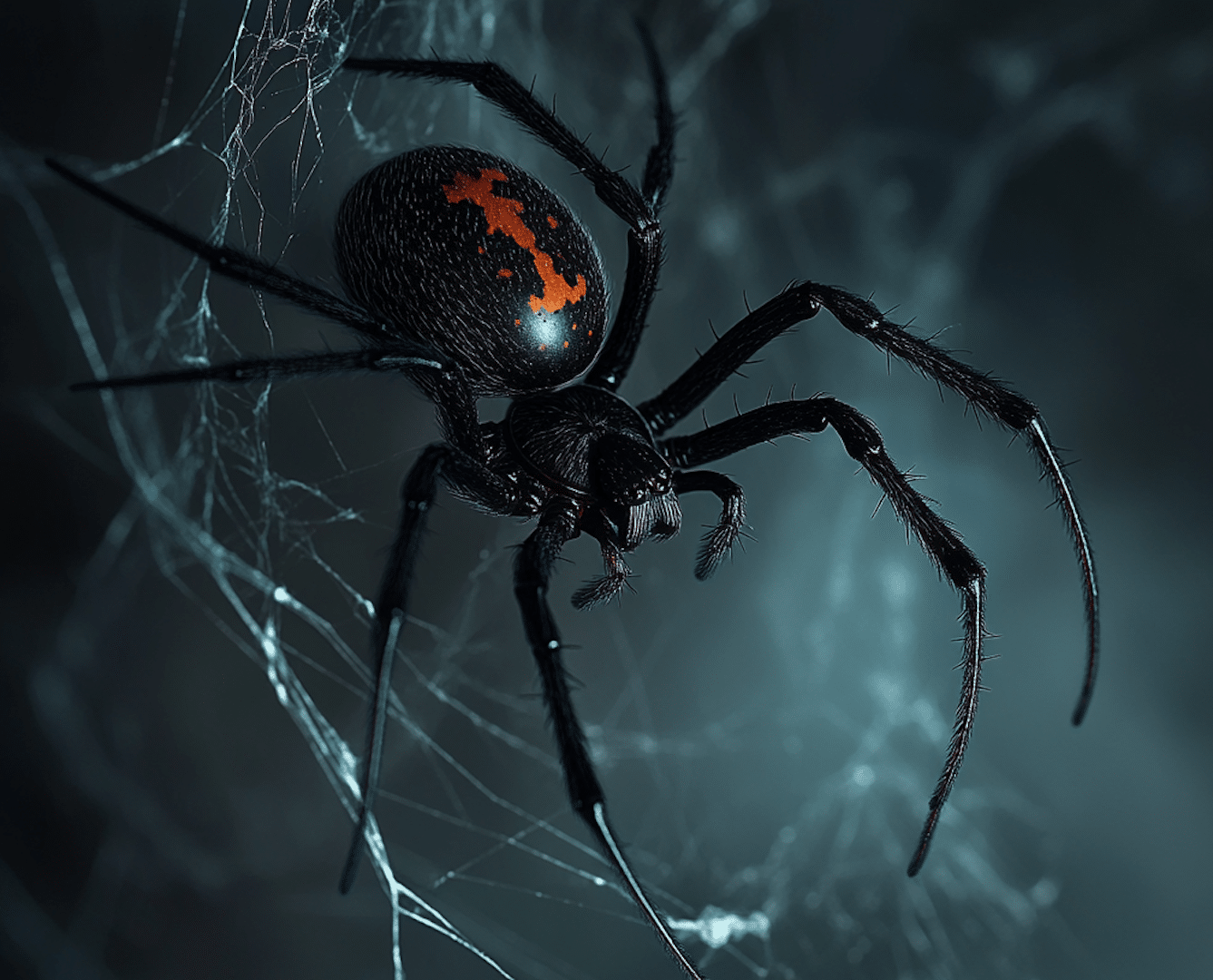Spiders are highly diverse arachnids, ranging in size, shape, and color to their habits and venom strength.
While spiders are helpful pest control experts, they’re usually a sign of a pest infestation at your home. For this reason, treating a pest infestation will subsequently help you get rid of your spiders.
Northeast Pennsylvania is home to several species of spiders, many of which you may already be familiar with and that already live in your homes.
From poisonous spiders to helpful garden spiders, we’ll run through the primary intruders you’ll likely find roaming your home or yard and tips to keep them away from your property as best as possible.

Common Spiders in Northeastern Pennsylvania
Funnel Web Spiders
Two common funnel web spiders exist in Northeast PA, including the grass spider and barn funnel weaver.
The primary difference is their common dwellings. For example, grass spiders dwell in the grass, while barn funnel weavers reside in the doorways and cracks of barns.
With life spans of up to 7 years, these spiders are some of the longest-living members on the list. However, due to their shy nature and fast movement, funnel web spiders are relatively illusive and conspicuous.
You can identify a funnel web spider by its elongated thorax, red-brown hues, and yellow hairs across the length of the body.
As their names indicate, funnel web spiders produce a unique, primarily horizontal web with a “funnel” or retreat located in the center or off to one side.
Danger-wise, funnel web spiders are some of the lowest on the list. They’re timid, with limited reports of bites. Reported bites usually include mild symptoms, such as localized redness, swelling, and slight pain.
Orb Weavers
Several Orb Weavers are present in the Northeastern area of the state; however, we’ll primarily focus on the yellow garden spider. This arachnid is one of the largest, flashiest, and most common in Pennsylvania. It is identified by its bright yellow color, large body, and long black/red legs.
Besides their physical appearance, orb weavers are commonly identified by their unique web shape, crafting large and ornate orb-shaped webs in gardens and tall grass with plenty of sun.
Like funnel weavers, orb weavers are non-aggressive and generally have harmless bites, causing no more pain and irritation than a bee sting or wasp bite.
Black Widows
This spider is identified by its shiny black body and characteristic red “hourglass” on the underside of the abdomen. The males are far smaller and possess a series of white markings and red spots atop a primarily black body.
Webs can be identified by their disorganized and relatively sparse design, especially in dark, undisturbed cavities such as wood piles, under stones, and in building crevices.
Though no deaths from black widow bites have been recorded in the US since the early 1980s, they can still be highly unpleasant. Black widow venom is primarily neurotoxic, producing a variety of generalized body symptoms that last an average of 4-7 days.
Jumping Spiders
The most common jumping spider in PA is the Phidippus audax, a compact hunting spider with a knack for daytime exploration.
These small spiders are identifiable by their hairy black bodies, tufts of hair protruding from the area around their large primary eyes and small secondary eyes, white, yellow, or orange spots, and iridescent green chelicerae.
Jumping spiders are aggressive and skilled hunters, utilizing their athleticism and powerful eyesight to pounce on prey from a great distance. Additionally, jumping spiders require light to hunt, making daytime sightings highly likely.
Generally, jumping spiders are shy creatures, hiding from humans whenever approached; even when threatened or held, they don’t often bite.
Jumpers also have extremely mild venom; if you happen to be bit by a jumping spider, you’ll likely only experience mild irritation, pain, and itching for 1 to 2 days.
Wolf Spiders
Wolf spiders are a common and diverse subspecies, with scientists noting 240 variations and 23 genera in the United States alone! However, in Pennsylvania, you’ll likely only encounter two species of wolf spiders: Hogna carolinensis and Tigrosa aspersa.
Both species are large and commonly found in homes. Female H. carolinensis can reach 25-35mm in length, and female T. aspersa can reach 18-25mm. Both spiders are distinctively brown; however, T. aspersa has prominent yellow markings at the leg joints and along the carapace near the eyes.
Both species of wolf spiders display similar behavior. They build retreats in the soil, beneath rocks and wood, or in other tight spaces, only emerging at night to hunt.
Regarding venom, wolf spider bites produce no notable medical side effects besides localized redness and swelling, which subside within 24 hours.
Daddy Long Legs
Also known as cellar spiders, daddy long legs are one of the most common spiders you’ll encounter in your home in Pennsylvania. These non-aggressive arachnids are often perched on sparsely woven webs in undisturbed locations, like the upper corners of rooms.
These spiders are easily identified by their small 6 to 8-mm body length and 50-mm leg length, hence their colloquial nickname. Other identifiers include a wide carapace, a long cylindrical abdomen, and a characteristic tan color.
These spiders possess a mild venom that isn’t likely to cause any medical issues. Daddy long legs are also extremely docile and aren’t likely to bite. In fact, bites are so rare that studies haven’t even been conducted to assess toxicity in mammals!
Broad-Faced Sac Spider
The broad-faced sac spider is a small but robust arachnid commonly found in Pennsylvania homes. Identified by its dark brown to black cephalothorax and lighter tan or gray abdomen, this spider is an active hunter that doesn’t rely on webs to capture prey.
Bites from broad-faced sac spiders are not medically significant but can cause localized swelling, pain, and mild itching.
What Spiders in Pennsylvania Are Considered Venomous?
The black widow is the only spider in Pennsylvania with venom that poses a significant medical concern. While other spiders, such as the broad-faced sac spider and yellow sac spider, have venom, their bites rarely cause anything more than minor irritation.
Again, there have been no medical deaths associated with black widow spider bites, though we strongly recommend seeking medical attention if a black widow spider bites you.
Are Spiders Dangerous?
Despite their reputation, most spiders in Pennsylvania are harmless. Even the black widow, the only medically significant spider in the state, rarely causes severe reactions.
Spider bites, in general, are uncommon, and when they do occur, they typically result in mild, localized symptoms such as redness, swelling, and slight pain. Most spiders prefer to avoid human interaction and will only bite if they feel threatened.
Signs of a Spider Infestation in Your Home
While it’s common to spot the occasional spider, they can quickly become a nuisance if they infest your home in large numbers. Here are some signs that your home is being overrun by spiders.
- An increase in visible spider webs, particularly in corners, ceilings, and undisturbed areas.
- The presence of egg sacs, which appear as small, silken pouches attached to surfaces.
- Frequent sightings of spiders in dark, secluded places such as basements, attics, and closets.
- An increase in insect activity, which serves as a food source for spiders.
- Shed exoskeletons or molted spider skins, indicating growth and reproduction.
- Finding spiders in areas with high humidity, such as bathrooms or crawl spaces.
Again, an increase in spider activity typically indicates an issue in your home, whether that be an increase in pests, a water leak, or a generally untidy home.
How to Keep Spiders Away
When it comes down to it, spiders are actually beneficial predators of smaller insects, providing your home with some free pest control! Better yet, you won’t have to worry about the dangerous Joro Spider in Pennsylvania any time soon.
Nevertheless, if you’re still worried or afraid of spiders in your home, we have some simple tips and tricks to ensure a spider-free home year-round.
Keep a Tidy Home
Spiders will generally only settle where food sources are bountiful; as spiders consume other small insects, the routine presence of ants, cockroaches, and flies will often lead to more spiders. You’ll effectively drive the arachnids away by eradicating spiders’ food sources.
So, ensure that you regularly clean your home and rid it of pest attractants such as food, spilled drinks, and garbage.
Additionally, be on the lookout for spiderwebs. If you spot one in the corner of your room or behind a piece of furniture, vacuum it up. The disturbance may be enough to drive the spiders elsewhere.
Natural Repellants
Are you looking to keep spiders out without killing them or subjecting your kids or pets to harmful chemicals? Consider using natural insect repellants like pest repellent plants, peppermint essential oil and vinegar.
After mixing a 50/50 concentration of vinegar and water or 10 to 15 drops of essential oil and water in a spray bottle, mist the areas where you find them lurking–reapply every 2 to 3 days as necessary.
Block Possible Entry Points
Even larger ones are small enough to squeeze into the tightest of cracks and openings, making a torn window screen, drafty door, or gap in your home’s siding the perfect place to gain entry.
So, if you’re noticing a large increase in spiders in a certain area of your home, do a quick walk around outside and note any possible entry points.
Seal gaps, cracks, and unnecessary holes with latex caulking and repair any broken window screens to keep spiders away. In addition, install proper seals on exterior doors, ensuring that your home is fortified against 8-legged intruders.
Professional Assistance
If all else fails, or you’re uncomfortable using insecticides on your own, don’t hesitate to contact your local pest control experts. With a wide array of treatment plans, the Pest Rangers can help you eliminate spiders in your home and around your property.
FAQs
Why am I seeing so many spiders in my home?
An increase in spider activity could indicate a higher population of insects in your home, which serves as their food source. Spiders are also more likely to enter homes in the fall as temperatures drop.
What should I do if I find a spider egg sac in my home?
Spider egg sacs can contain hundreds of eggs, so it’s best to remove them promptly. Use a vacuum or carefully dispose of them by sealing them in a plastic bag and discarding them outside.
Do spider bites require medical treatment?
Most spider bites cause only mild irritation and can be treated with ice, antihistamines, and over-the-counter pain relievers. However, if you suspect a black widow bite or experience severe symptoms such as muscle cramps, difficulty breathing, or fever, seek medical attention immediately.



























